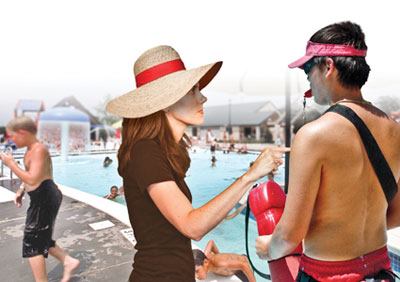A lifeguard’s role on the pool deck is multifaceted. It involves successful navigation of high-stress situations, from water emergencies to conflict resolution.
Everyday lifeguards are placed in situations where they must work with patrons and employees to find solutions to any number of problems. When a situation arises, guards need to react appropriately and efficiently, with the goal of ensuring a quality experience for all patrons. The best way to develop these critical skills is through regular in-service training.
Using real-life scenarios as part of your in-service training is an effective approach to developing critical thinking skills. Create scenarios based on common disagreements that occur at your facility, as well as the more rare, but conceivably destructive, conflicts that could arise.
When conducting your scenario-based in-service, divide the lifeguards into groups and assign each group a scenario. Each group should consist of two lifeguards on duty and one supervisor on the deck. All other lifeguards will act as patrons or program participants and will be assigned various roles based on the scenario. Have each group role-play their assigned scenario to a point at which the situation is diffused by the lifeguards and supervisor.
Do not offer advice or assistance while the scenario is being conducted. This helps your staff members build their critical thinking and decision-making skills. After each scenario, bring everyone together to discuss and review the solution presented and offer possible alternatives.
Following are some examples of scenarios and possible solutions that can be used as part of your in-service training.
Scenario 1: Swim Testing
Problem: A lifeguard who is not on surveillance duty approaches a family that has just entered the pool area and offers to swim-test their children. One parent is immediately offended by the idea of swim testing. Once the children’s swimming abilities have been determined, the guard informs the parent that the children must stay in the shallow water and be within arm’s reach of a parent or be in a Coast Guard-approved life jacket.
The parent becomes angry because he had not intended to swim with the children, nor does he want them to wear the life jackets.
Possible solution: The lifeguard explains that the aquatics facility’s No. 1 responsibility is to ensure the safety of the children and adults in their care and that the swim assessment is a tool used to identify nonswimmers. This knowledge enhances the safety of all patrons.
The guard then explains the policy that a child may swim without the aid of a life jacket if the parent swims with the child and maintains touch supervision (guard should demonstrate) at all times. The guard also may encourage the parents to enroll their children in swim lessons and provide them with the date of when the next session begins.
Scenario 2: Patron Mad at Lifeguard
Problem: A teenage patron breaks a posted rule by diving into the shallow end of the pool. The lifeguard on duty tries to correct the patron’s behavior by using an appropriate decision-making model. A short time later, the patron proceeds to break the same rule again and the guard attempts to correct the behavior a second time. The patron becomes angry and confronts the lifeguard about his perceived “misuse of authority.”
Possible solution: The lifeguard’s first responsibility in this situation is to continue scanning the water. In this situation, the guard should call the supervisor on duty for help by blowing his or her whistle in accordance with the facility’s policies.
The supervisor then takes over the situation, allowing the guard to continue his or her surveillance duties. The role of the supervisor is to stop further escalation of the situation and to work with the member to find a resolution.
It’s important to remind your lifeguards that their primary role is to scan the water and provide for the safety of the facility patrons. Conflicts on the deck should be handled by a supervisor or a guard who is not on surveillance duty. At no point should a staff member have any physical contact with a patron in a conflict situation. The staff should not physically remove someone from the pool or the facility. If a situation reaches a point at which someone is asked to leave the facility and he or she refuses, the police should be called. A facility has the right to ask someone to leave the premises if employees believe the individual is a danger to others or themselves.
In an ideal world, everyone would follow the rules and show mutual respect toward one another. However, conflict does happen. Well-trained, professional lifeguards should be able to handle any situation presented to them.


